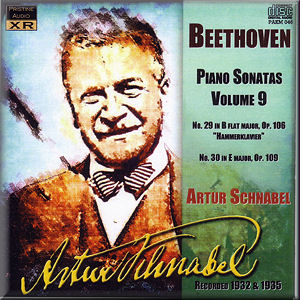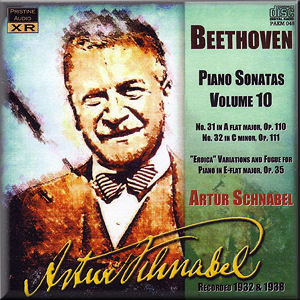 |
 |
| 
Availability
CD & Download: Pristine
Classical
|
Ludwig van BEETHOVEN
(1770 -1827)
Piano Sonatas - Volume 9
Sonata for Piano No. 29 in B flat, Op. 106, ‘Hammerklavier’
(1818) [40’21].
Sonata for Piano No. 30 in E major, Op. 109 (1820) [20:18]
 Artur Schnabel (piano)
Artur Schnabel (piano)
rec. 21 March (Op.109) 1932; 3-4 November 1935 (op.106), Studio
No. 3, Abbey Road, London.
 PRISTINE AUDIO PAKM 046 [60:59]
PRISTINE AUDIO PAKM 046 [60:59] |

Availability
CD & Download: Pristine
Classical |
Piano Sonatas - Volume 10
Sonata for Piano No. 31 in A flat major, Op. 110 (1821-2) [18:51]
Sonata for Piano No. 32 in C minor, Op. 111 (1822) [26:18]
Variations and Fugue in E flat, Op. 35 ‘Eroica’ (1802)
[21:12]
 Artur Schnabel (piano)
Artur Schnabel (piano)
rec. 21-22 January 1935 (Op.110, 111); 9 November 1938 (Op.36), Studio
No. 3, Abbey Road, London.
 PRISTINE AUDIO PAKM 048 [68:43]
PRISTINE AUDIO PAKM 048 [68:43] |
| |
As a comparative Schnabel virgin, I hesitate to offer many supposed
insights regarding his interpretative prowess. Litres of ink
have already been spilled by the real devotees to illuminate
his genius. Most readers will already have decided whether they
want to hear historical recordings or whether they respond to
Schnabel’s style. Can you tolerate his slips and “splashiness”
in return for the energy and spontaneity of his interpretations?
We have perhaps become far too accustomed to technical perfection
at the expense of expressive freedom. Now that modern economic
conditions having hastened the decline of studio recordings
in favour of live issues we should now perhaps be more tolerant
of the vicissitudes inherent in live recordings. Schnabel famously
disliked the restrictions and inconveniences of the recording
studio. Even if modern pianists are technically more adept,
if we heard performances such as these live today we would hardly
react with anything other than gratitude and astonishment.
From a practical point of view, the main area of concern will
be the sound quality and that is probably of interest to two
main groups. The old hands will want to know whether it’s
worth the investment replacing their current versions. Pristine
offer these latest re-masterings of the late piano sonatas by
Andrew Rose. Then there are those aficionados who are curious
about the Schnabel legend and might simply want to start with
the best available.
There is an alternative from Naxos in Mark Obert-Thorn’s
re-engineering of the sonatas for Naxos. They are cheaper than
Pristine’s issues, but they cannot compare as a listening
experience with Andrew Rose’s superb reincarnation of
these classic performances, by far the finest to-date. Regis
have issued a super-bargain complete 8 CD set licensed from
Nuova Era but don’t touch it with the proverbial barge-pole:
there is absolutely no comparison between what Andrew Rose has
done here to enhance the original 78s and the sad, distant splatterings
you hear on Regis. On Pristine, there is very little hiss or
“muddiness” at the bottom and a minimum of “clanginess”
at the top. The added depth of sound allows the left hand a
greater, welcome prominence. The extra reverberation is perhaps
a little wearing on the ear but that’s remedied by turning
down the volume a little. The ferocity of Schabel’s attack,
the pathos, delicacy and poignancy of his tender touch in the
slow movements and the freedom and poetry of his genius emerge
more cleanly and clearly than ever before. Despite the aforementioned
technical weaknesses in faster passages such as the Allegro
opening Op.106, his strengths more than compensate and his dynamism
virtually silences criticism. Schnabel’s way with the
Scherzo is decidedly aggressive but his interpretation is all
of a piece, contrasting wonderfully with the rapt Adagio sostenuto
which follows. There is wonderful sonority in the left hand
beginning at 2:35 and the new melody anticipating Chopin which
sings over that bass ground makes one more grateful than ever
for the richness of Pristine’s sound. The odd slip notwithstanding,
Schnabel’s technique and fingerwork reveal remarkable
virtuosity in the Fugue of the last movement.
The opening to Op.30 reveals Schnabel’s cantabile quality,
especially in his lightness of touch when returning to the first
subject. His thunderous assurance in the concluding Andante
is mightily impressive - but that is the essence of Schnabel’s’
art: he encompasses all the moods required, from the massive
profundity of the first movement of Op.110 to the sparkling
brilliance of its Allegro molto to the introspective serenity
of the final Adagio. Op.111 is just as masterly; one is always
completely absorbed by the integrity and aptness of his interpretation
whichever sonata one is listening to. Given that the technical
challenges stretch him to the limits, one sometimes has the
impression that Schnabel is tilting at windmills but it is that
dauntless courage which renders these performances so touchingly
human. The second movement serves as a paradigm to illustrate
this and the human condition in general. A starkly simple statement
undergoes variations until it becomes increasingly fragmented
and tormented, then order, reason and optimism are restored.
The Op.35 “Eroica” Variations and Fugue is of a
somewhat lower order but it was an ambitious and innovatory
composition which calls for a huge variety of colour and mood,
and the ability to take a long view in order to hold it all
together. All of this plays to Schnabel’s strengths. He
gives us witty, relaxed accounts but rises to the mysteries
unfolding in the last variation. The Fugue has a mercurial,
plastic quality in his hands which perfectly underlines the
teasing, pleasing irony of Beethoven’s romanticising of
that most baroque of forms.
Comparisons with modern recordings are otiose; most serious
collectors will want Schnabel’s Beethoven on Pristine
in the same way that they want Casals’ Bach cello suites
on EMI: they are both artistically deeply satisfying in their
own right but also offer a unique and seminal Urtext by which
to judge later accounts. I favour Richter, Gilels and early
Lupu for more modern sound which clearly illustrates my own
taste for the extrovert, demonstrative interpretative school
of Schnabel rather than the more cerebral, refined mode of Brendel,
Lewis or Pollini.
Ralph Moore
|
|

